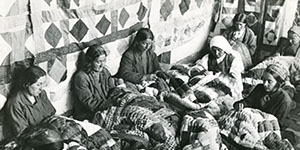
May my daughter learn to sit
May she wear a thimble
On a white felt carpet may she sit and sew
—Turkmen lullaby
Kurak and kurama are the Turkic words most Central Asians use for “patchwork.” Scholars surmised that because these terms were transmitted to Farsi-speaking Tajiks by Turkic-speaking people, they were of Turkic origin. Indeed, kurma and kurmak in modern Turkish means to set-up, build, put together, to create; and kura and kurama in Kyrgyz are defined as combined, composite, or made of separate pieces.
We know little of the origins of patchwork in Central Asia, although there are two theories. One small group of Kyrgyz ethnographers suggests that of all the traditional arts, kurak is one of the most ancient, based on the discovery of a petroglyph in the Kochkorskaya Valley, dated to the eighth century. It pictures riders on horseback with traditional nomadic saddles, stirrups, bits, saddle-girths, and what is thought to be a kurak horsecloth (see image carousel).
A second theory, more broadly accepted among ethnographers, links the appearance and development of kurak to the expansion of trade with the Russian Empire. Central Asia was the main supplier of cotton to Russia in the second half of the nineteenth century, and in turn became a large consumer of Russian factory-made cloth when it entered the region's bazaars. Silks, brocades, velvets, and embroideries were also used in both patchwork and whole cloth quilts—particularly in sedentary regions where the traditional costume of the elite, constructed of luxury cloth, denoted status. But fragments also found their way to the kurak of pastoral nomads. While raw materials and textile production varied, vigorous trade and constant movement along the Great Silk Road contributed to the evolution of the rich patchwork and quilt tradition we know today.